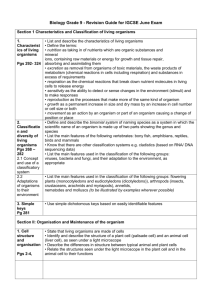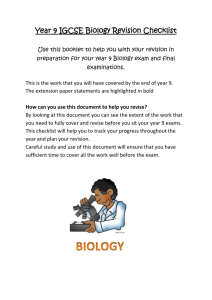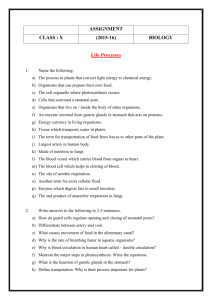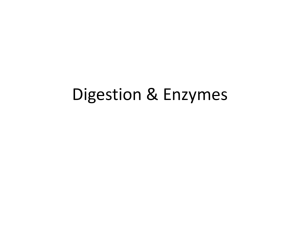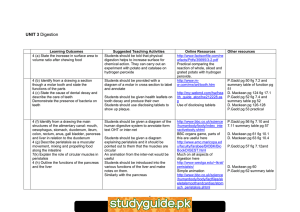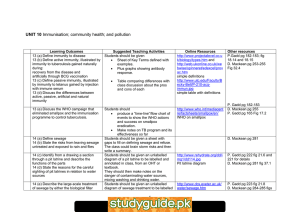Section 1 Characteristics and Classification of living organisms (
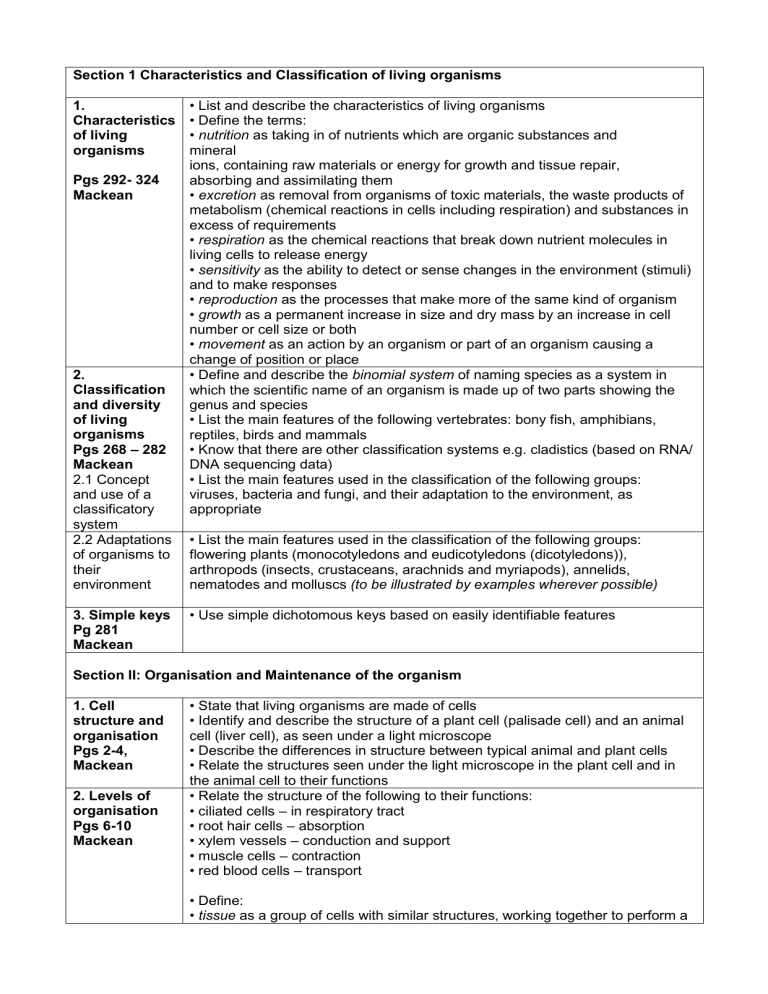
Section 1 Characteristics and Classification of living organisms (- I(
10Issons
1.
Characteristics of living
• List and describe the characteristics of living organisms
• Define the terms:
• nutrition as taking in of nutrients which are organic substances and organisms mineral ions, containing raw materials or energy for growth and tissue repair,
Pgs 292- 324
Mackean absorbing and assimilating them
• excretion as removal from organisms of toxic materials, the waste products of metabolism (chemical reactions in cells including respiration) and substances in excess of requirements
• respiration as the chemical reactions that break down nutrient molecules in living cells to release energy
• sensitivity as the ability to detect or sense changes in the environment (stimuli) and to make responses
• reproduction as the processes that make more of the same kind of organism
• growth as a permanent increase in size and dry mass by an increase in cell
2.
Classification and diversity of living organisms
Pgs 268 system
– 282
Mackean
2.1 Concept and use of a classificatory number or cell size or both
• movement as an action by an organism or part of an organism causing a change of position or place
• Define and describe the binomial system of naming species as a system in which the scientific name of an organism is made up of two parts showing the genus and species
• List the main features of the following vertebrates: bony fish, amphibians, reptiles, birds and mammals
• Know that there are other classification systems e.g. cladistics (based on RNA/
DNA sequencing data)
• List the main features used in the classification of the following groups: viruses, bacteria and fungi, and their adaptation to the environment, as appropriate
2.2 Adaptations of organisms to their environment
3. Simple keys
Pg 281
Mackean
• List the main features used in the classification of the following groups: flowering plants (monocotyledons and eudicotyledons (dicotyledons)), arthropods (insects, crustaceans, arachnids and myriapods), annelids, nematodes and molluscs (to be illustrated by examples wherever possible)
• Use simple dichotomous keys based on easily identifiable features
Section II: Organisation and Maintenance of the organism
1. Cell structure and organisation
Pgs 2-4,
Mackean
• State that living organisms are made of cells
• Identify and describe the structure of a plant cell (palisade cell) and an animal cell (liver cell), as seen under a light microscope
• Describe the differences in structure between typical animal and plant cells
• Relate the structures seen under the light microscope in the plant cell and in
2. Levels of organisation
Pgs 6-10
Mackean the animal cell to their functions
• Relate the structure of the following to their functions:
• ciliated cells – in respiratory tract
• root hair cells – absorption
• xylem vessels – conduction and support
• muscle cells – contraction
• red blood cells – transport
• Define:
• tissue as a group of cells with similar structures, working together to perform a
3. Size of specimens
4. Movement in and out of cells
Pgs 26-34
Mackean
4.1 Diffusion
4.2 Active
Transport shared function
• organ as a structure made up of a group of tissues, working together to perform specific functions
• organ system as a group of organs with related functions, working together to perform body functions using examples covered in Sections II and III
• Calculate magnification and size of biological specimens using millimetres as units
• Define diffusion as the net movement of molecules from a region of their higher concentration to a region of their lower concentration down a concentration gradient, as a result of their random movement
• Describe the importance of diffusion of gases and solutes and of water as a solvent
4.3 Osmosis
5. Enzymes
Pgs 14-18
6. Nutrition
Pgs 86-107
Mackean
6.1 Nutrients
• Define active transport as movement of ions in or out of a cell through the cell membrane, from a region of their lower concentration to a region of their higher concentration against a concentration gradient, using energy released during respiration
• Discuss the importance of active transport as an energy-consuming process by which substances are transported against a concentration gradient, e.g. ion uptake by root hairs and uptake of glucose by epithelial cells of villi
• Define osmosis as the diffusion of water molecules from a region of their higher concentration (dilute solution) to a region of their lower concentration
(concentrated solution), through a partially permeable membrane
• Describe the importance of osmosis in the uptake of water by plants, and its effects on plant and animal tissues
• Describe and explain the importance of a water potential gradient in the uptake of water by plants
• Define the term catalyst as a substance that speeds up a chemical reaction and is not changed by the reaction
• Define enzymes as proteins that function as biological catalysts
• Investigate and describe the effect of changes in temperature and pH on enzyme activity
• Explain enzyme action in terms of the ‘lock and key’ model
• Explain the effect of changes in temperature and pH on enzyme activity
• Describe the role of enzymes in the germination of seeds, and their uses in biological washing products and in the food industry (including pectinase and fruit juice)
• Outline the use of microorganisms and fermenters to manufacture the antibiotic penicillin and enzymes for use in biological washing powders
• Describe the role of the fungus Penicillium in the production of antibiotic penicillin
• Define nutrition as taking in of nutrients which are organic substances and mineral ions, containing raw materials or energy for growth and tissue repair, absorbing and assimilating them
• List the chemical elements that make up:
• carbohydrates
• fats
• proteins
• Describe the synthesis of large molecules from smaller basic units, i.e.
• simple sugars to starch and glycogen
• amino acids to proteins
• fatty acids and glycerol to fats and oils
Describe tests for:
• starch (iodine solution)
• reducing sugars (Benedict’s solution)
6.3 Animal nutrition
6.3.1 Diet
6.3.2 Food supply
6.3.3 Human alimentary canal
6.3.4
Mechanical and physical digestion
6.3.5 Chemical digestion
6.3.6
• protein (biuret test)
• fats (ethanol)
• List the principal sources of, and describe the importance of:
• carbohydrates
• fats
• proteins
• vitamins (C and D only)
• mineral salts (calcium and iron only)
• fibre (roughage)
• water
• Describe the deficiency symptoms for:
• vitamins (C and D only)
• mineral salts (calcium and iron only)
• Describe the use of microorganisms in the food industry, with reference to yoghurt and single cell protein
• Describe the uses, benefits and health hazards associated with food additives, including colourings
• State what is meant by the term balanced diet and describe a balanced diet related to age, sex and activity of an individual
• Describe the effects of malnutrition in relation to starvation, coronary heart disease, constipation and obesity
• Discuss ways in which the use of modern technology has resulted in increased food production (to include modern agricultural machinery, chemical fertilisers, pesticides and herbicides, artificial selection)
• Discuss the problems of world food supplies
• Discuss the problems which contribute to famine (unequal distribution of food, drought and flooding and increasing population)
• Define ingestion as taking substances (e.g. food, drink) into the body through the mouth
• Define egestion as passing out of food that has not been digested, as faeces, through the anus
• Identify the main regions of the alimentary canal and associated organs including mouth, salivary glands, oesophagus, stomach, small intestine: duodenum and ileum, pancreas, liver, gall bladder, large intestine: colon and rectum, anus
• Describe the functions of the regions of the alimentary canal listed above, in relation to ingestion, digestion, absorption, assimilation and egestion of food
(cross reference 6.3.4, 6.3.5, 6.3.6 and 6.3.7)
• Define digestion as the break-down of large, insoluble food molecules into small, water soluble molecules using mechanical and chemical processes
• Identify the types of human teeth and describe their structure and functions
• State the causes of dental decay and describe the proper care of teeth
• Describe the process of chewing
• Describe the role of longitudinal and circular muscles in peristalsis
• Outline the role of bile in emulsifying fats, to increase the surface area for the action of enzymes
• Describe how fluoride reduces tooth decay and explain arguments for and against the addition of fluoride to public water supplies
• State the significance of chemical digestion in the alimentary canal in producing small, soluble molecules that can be absorbed
• State where, in the alimentary canal, amylase, protease and lipase enzymes are secreted
• State the functions of a typical amylase, a protease and a lipase, listing the substrate and end-products
Absorption
6.3.7
Assimilation
6.2 Plant nutrition
Pgs 35 - 46
6.2.1
Photosynthesis
• Define absorption as movement of digested food molecules through the wall of the intestine into the blood or lymph
• Identify the small intestine as the region for the absorption of digested food
• Describe the significance of villi in increasing the internal surface area of the small intestine
• Describe the structure of a villus, including the role of capillaries and lacteals
• State the role of the hepatic portal vein in the transport of absorbed food to the liver
• Identify the role of the small intestine and colon in absorption of water (the small intestine absorbs 5 –10 dm3 per day, the colon 0.3–0.5 dm3 per day)
• Define assimilation as movement of digested food molecules into the cells of the body where they are used, becoming part of the cells
• Describe the role of the liver in the metabolism of glucose (glucose → glycogen) and amino acids (amino acids → proteins and destruction of excess amino acids)
• Describe the role of fat as an energy storage substance
• Define deamination as removal of the nitrogen containing part of amino acids to form urea, followed by release of energy from the remainder of the amino acid
• State that the liver is the site of breakdown of alcohol and other toxins
Core
• Define photosynthesis as the fundamental process by which plants manufacture carbohydrates from raw materials using energy from light
• State the word equation for the production of simple sugars and oxygen
• Investigate the necessity for chlorophyll, light and carbon dioxide for photosynthesis, using appropriate controls
• Describe the intake of carbon dioxide and water by plants
• Explain that chlorophyll traps light energy and converts it into chemical energy for the formation of carbohydrates and their subsequent storage
Supplement
• State the balanced equation for photosynthesis in symbols
6CO
2
+ 6H
2
O (light and chlorophyll) ------→ C
6
H
12
O
6
+ 6 O
2
• Investigate and state the effect of varying light intensity, carbon dioxide concentration and temperature on the rate of photosynthesis (e.g. in submerged aquatic plants)
• Define the term limiting factor as something present in the environment in such short supply that it restricts life processes
• Explain the concept of limiting factors in photosynthesis
• Explain the use of carbon dioxide enrichment, optimum light and optimum temperatures in glasshouse systems
